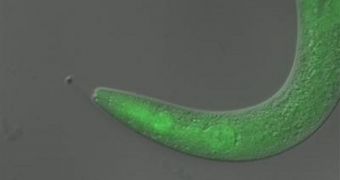Scientists in Canada announce the development of a new light “switch,” which has the ability to basically trigger paralysis from within the body of lab worms. All it takes for that to happen is a beam of ultraviolet light. As long as it shines, the animals remain immobilized, and can only move when the light stops. Normal light, on the other hand, has the effect of reversing paralysis, and instilling new life in the small creatures. The research team behind the accomplishment is based at the Simon Fraser University, in Burnaby, British Columbia.
This is the first time such a light-activated switch is demonstrated in animals, the scientists say. Details of their work have been published in the latest issue of the respected scientific Journal of the American Chemical Society (JACS). The science team was led by Neil Branda PhD, of the university's Department of Molecular Biology and Biochemistry. She highlights the fact that photoswitches, the scientific name for materials that are activated with nothing more than light, have been around for many years, and that it was only a matter of time until someone managed to achieve such a level of control using them.
In fact, these materials are so widespread that they are used in a large number of applications, including in medicine. For example, photodynamic therapy is a course of treatment used to combat cancer. It relies on light-sensitive materials and photoreactions, and some hospitals have been using them for a long time. However, unlike photoswitches, light-sensitive materials do not have the ability to revert to their initial “settings” once they've been exposed to photons.
The material known as dithienylethene was used in the new investigation, to set the basis for the photoswitch. The researchers produced sufficient amounts of the stuff, and then they grew C. elegans, a type of small, pinhead-sized worms, which were exposed to the stuff. Once blue light was shun on them, the little animals turned blue, and almost instantly became paralyzed. Most of the worms survived this cycle. The researchers, however, indicate that numerous uses could be found for the new material, especially in light-based therapy, medicine and medical research.

 14 DAY TRIAL //
14 DAY TRIAL //